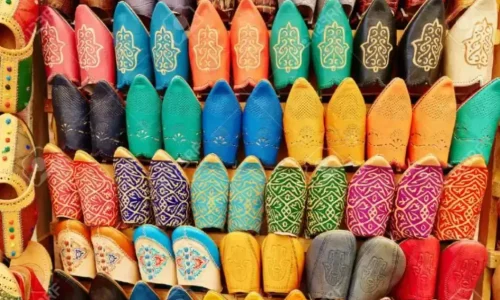They were two little babouches, babouches for two pretty little feet….
Babouches, but babouches from Tafraoute, the capital of babouches.
Tafraoute, city of the south Morocco, in the mountain, in the middle of the rocks all pink in the sunset.
Tafraoute, in the middle of the almond trees…
There, Ahmed lived…
Ahmed has always lived in Tafraoute, his father too, his grandfather already, and maybe even his great-grandfather, and his great-great-grandfather too….
His father made babouches, his grandfather made babouches, his great-grandfather made babouches and even his great-great-grandfather …..
On that his son Mohamed, will also make babouches, the most beautiful babouches of Morocco….
Thanks to the sale of the babouches, the most beautiful babouches of Morocco, their stomach will never be “Tafraoute”, which means, they will never be hungry…
Ahmed had made two beautiful babouches, black babouches with golden braids!
He had worked, worked, Mohamed his son had come to help him. He had placed the golden braids that decorate the two small shoes…
Now he was going to put them on the shelf next to the other slippers ….
What he did not know, Ahmed, is that these two were not ordinary slippers! First of all, they spoke! yes, yes, they spoke! There was right babouche and left babouche…look, said right babouche: I lean towards you!
-look, said left babouche I also lean towards you!
-Promise me, said babouche right, never to leave me.
-How can I leave you? Have you ever seen anyone buy a single babouche?
-Of course, but promise to always follow me!
-Always follow you? I can’t! One time you’ll be in front, the other time not, you’ll be behind!
-I would have liked, me, to be always in front !
-Bof! behind, in front, what does it matter! says left babouche.
-Let’s try! do you want? in front, you follow, in front, you follow!
-Not very practical to walk on the stony paths!
-I won’t go on the paths! the stones would hurt my soles! we would have holes because of the sharp rocks!
-Ah! well, said left babouche who was always in agreement! and, what are we going to do?
Little babouche began to dream….
I would like, I would like…to put on dancer’s feet, agile feet, which would dance, would turn, in a garden full of flowers!
-Smell! I can already smell the orange blossoms, the hibiscus, it is fresh under the leaves! Above us, the stars, the beautiful starry sky of the desert!
-Of the desert, says left babouche, but it will be hot, the sand will penetrate everywhere!
-Think a little, says right babouche, we are in the desert, in an oasis, it is the festival, hold a wedding! We are the babouches of the bride, see how beautiful she is!
Ah! the beautiful life of babouche!
-Wake up, says left babouche, here is the world, let us listen!
-I would like some babouches, for the wedding of my daughter, says a gentleman.
-Move over, babouches, these customers are for us!
We saw the slippers twisting, moving forward, turning to be admired, so much so that we saw only them!
-These ones, please!
Ahmed took the slippers, wrapped them in a pretty paper, made a beautiful package and gave it to the girl.
She thanked him with a beautiful smile and hugged them to her heart.
The little slippers heard knock-knock and already in the box, a step to the right, a step to the left …. They began to dance !
How beautiful she was Naïma ! never, never bride was more beautiful !
As soon as she put on her slippers, she felt light, light, like a bird ! She started to dance, to fly, to turn !
They were not ordinary babouches ! They were babouches from Tafraoute the capital of babouches !
When the party was over, Naïma, put away the babouches, but when it takes him a little bit of blues, when the rocks of Tafraoute become all pink, the evening…
Naïma puts on her babouches, she starts to dance, to turn, to fly…
Because they are not ordinary babouches, they are babouches from Tafraoute… The capital of babouches !!!



